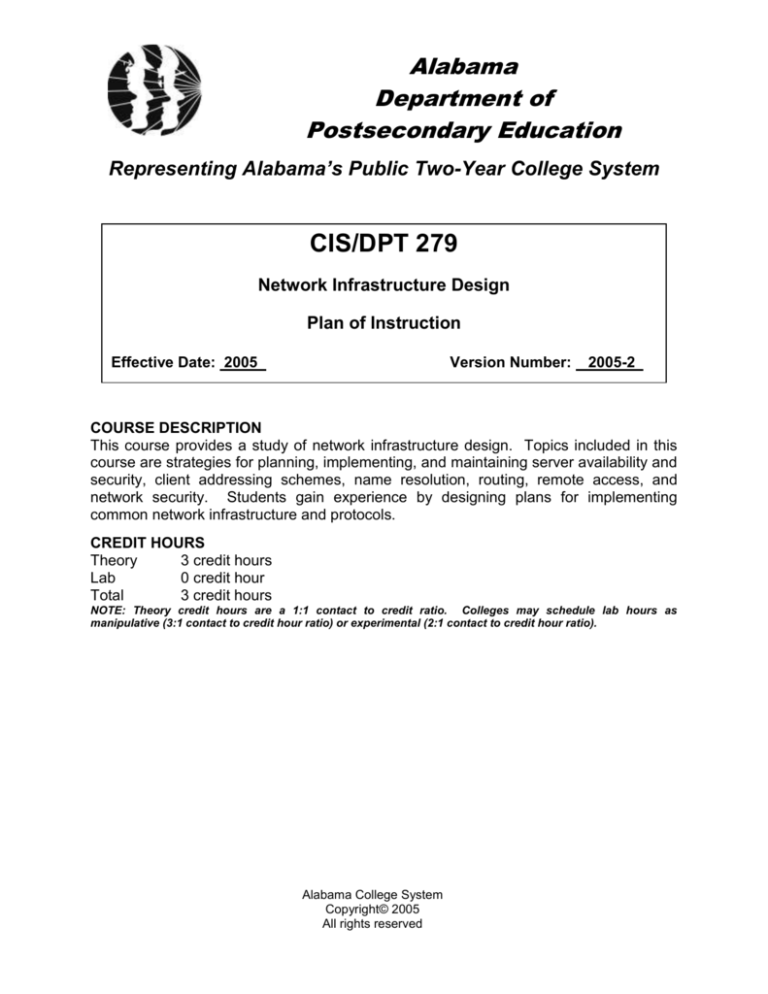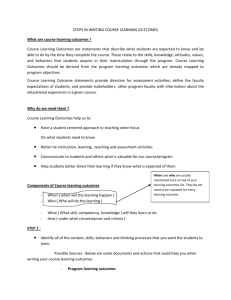
Alabama
Department of
Postsecondary Education
Representing Alabama’s Public Two-Year College System
CIS/DPT 279
Network Infrastructure Design
Plan of Instruction
Effective Date: 2005
Version Number:
2005-2
COURSE DESCRIPTION
This course provides a study of network infrastructure design. Topics included in this
course are strategies for planning, implementing, and maintaining server availability and
security, client addressing schemes, name resolution, routing, remote access, and
network security. Students gain experience by designing plans for implementing
common network infrastructure and protocols.
CREDIT HOURS
Theory
3 credit hours
Lab
0 credit hour
Total
3 credit hours
NOTE: Theory credit hours are a 1:1 contact to credit ratio. Colleges may schedule lab hours as
manipulative (3:1 contact to credit hour ratio) or experimental (2:1 contact to credit hour ratio).
Alabama College System
Copyright© 2005
All rights reserved
Network Infrastructure Design
CIS 279
PREREQUISITE COURSES
Determined by college unless stated otherwise
CO-REQUISITE COURSES
Determined by college unless stated otherwise
INSTRUCTIONAL NOTE: Students should possess a basic knowledge of concepts
related to computer networks and server administration.
PROFESSIONAL COMPETENCIES:
Design a network infrastructure.
Design network infrastructure security.
GENERAL INSTRUCTIONAL OBJECTIVES:
The cognitive objective for this course is for students to comprehend foundational
knowledge of network infrastructure design.
There are no performance objectives directly associated with this course.
There are no affective domains directly associated with this course.
PROFESSIONAL COMPETENCIES/OBJECTIVES:
Unless otherwise indicated, evaluation of student’s attainment of objectives is based on
knowledge gained from this course. During performance evaluations, students will be
provided necessary tools, equipment, materials, specifications, and any other resources
necessary to accomplish the task. Specifications may be in the form of, but not limited
to, manufacturer’s specifications, technical orders, regulations, national and state
codes, certification agencies, locally developed lab assignments, or any combination of
specifications
ACS Copyright© 2005
All rights reserved
2
Network Infrastructure Design
CIS 279
MODULE A – NETWORK INFRASTRUCTURE PLANNING
PROFESSIONAL COMPETENCIES
A1.0 Design a network
infrastructure. (C)
PERFORMANCE OBJECTIVES
A1.1 This competency is measured cognitively.
ENABLING OBJECTIVES
A1.1.1 Define terms associated with network infrastructure planning.
A1.1.2 Describe concepts related to network infrastructure planning.
A1.1.3 Explain considerations for assigning IP addresses.
A1.1.4 Calculate IP subnets and associated address pools.
A1.1.5 Determine DHCP server deployment.
A1.1.6 Explain considerations for IP routing.
A1.1.7 Determine router deployment.
A1.1.8 Explain considerations for name resolution.
A1.1.9 Design a DNS namespace.
A1.1.10 Determine DNS name server deployment.
A1.1.11 Explain considerations for Internet connectivity.
A1.1.12 Determine NAT and proxy server deployment.
A1.1.13 Explain concepts related to server clustering.
A1.1.14 Determine network load balancing deployment.
A1.1.15 Determine server cluster deployment.
KSA
Indicators
A
B
B
C
C
B
C
B
C
C
B
C
B
C
C
MODULE B – NETWORK INFRASTRUCTURE SECURITY
PROFESSIONAL COMPETENCIES
B1.0 Design network infrastructure
security. (C)
PERFORMANCE OBJECTIVES
B1.1 This competency is measured
cognitively.
KSA
ENABLING OBJECTIVES
Indicators
B1.1.1 Define terms associated with network infrastructure security.
A
B1.1.2 Explain concepts associated with network infrastructure security.
B
B1.1.3 Explain considerations for selecting computers for specific
C
applications.
C
B1.1.4 Explain considerations for establishing computer security settings.
B
B1.1.5 Explain concepts associated with hardening servers.
C
B1.1.6 Explain security considerations when determining configurations
for various network servers.
B
B1.1.7 Explain concepts related to designing public key infrastructure.
C
B1.1.8 Explain considerations for designing a CA infrastructure.
B
B1.1.9 Explain concepts related to securing network communications.
C
B1.1.10 Explain considerations for IPSec.
C
B1.1.11 Determine IPSec deployment.
ACS Copyright© 2005
All rights reserved
3
Network Infrastructure Design
CIS 279
COURSE CONTENT OUTLINE
MODULE A – NETWORK INFRASTRUCTURE PLANNING
Network infrastructure overview
- Network infrastructure design components
- Security requirements
- Performance requirements
- Selecting protocols
- Locating physical resources
- Network infrastructure maintenance
Planning a TCP/IP network infrastructure
- Planning IP address assignment
o IP addressing overview
o IP addressing requirements
o Subnetting IP addresses
o Manual/static IP addressing
o DHCP server deployment
- Planning IP routing
o Router functions
o LAN routing
o WAN routing
o Routing tables
o Routing protocols
- Planning Name resolution
o Name resolution overview
o Determining DNS requirements
o Designing a DNS namespace
o Planning DNS name servers
- Planning Internet connectivity
o Determining Internet connectivity requirements
o Network Address Translation (NAT)
o Proxy Servers
Server Clustering
- Clustering overview
- Network load balancing
o Planning deployment
o Monitoring
- Server clusters
o Hardware configuration
o Planning deployment
o Failover policies
ACS Copyright© 2005
All rights reserved
4
Network Infrastructure Design
CIS 279
MODULE B – NETWORK INFRASTRUCTURE SECURITY
Overview of network infrastructure security
- Selecting computers
o Client systems
o Servers
- Security settings
o Securing computers
o Securing updates
o Securing remote access
Hardening Servers
- Overview
o Creating a baseline
o Server roles
o Auditing and logging
- Role-specific server configurations
o Securing network directory servers
o Securing infrastructure servers
o Securing file and print servers
o Securing application servers
Designing a Public Key Infrastructure
- Overview
o Key encryption
o Certificates
o Certificate authorities (CA)
- Designing a CA infrastructure
o Defining certificate requirements
o Defining CA requirements
o Protecting a CA
o CA management
Securing Network Communications
- Overview of packet filtering
o Threats
o Ports and protocols
o Packet filtering criteria
- IPSec
o Functions and standards
o Modes
o IPSec components
o Planning IPSec deployment
ACS Copyright© 2005
All rights reserved
5
Network Infrastructure Design
CIS 279
RECOMMENDED METHODS OF EVALUATION: The tables of specifications below identify the
number of cognitive (knowledge) enabling objectives, psychomotor (performance) objectives,
and affective (attitudinal) objectives per module. Instructors should develop sufficient
numbers of evaluation items to ensure complete coverage of each cognitive and/or
psychomotor objective identified in each module. For cognitive objectives, use appropriate
written test type based on the complexity indicator for each objective. Create comprehensive,
checklist evaluations for each psychomotor objective.
Facts/Nomenclature (A/a): Multiple Choice, Fill-in, List, Matching, Alternative Response
(true/false or yes/no)
Principles/Procedures (B/b): Multiple Choice, Fill-in, List, Short Answer
Analysis/Operating Principles (C/c): Multiple Choice, Short Answer, Essay
Evaluation/Complete Theory (D/d): Multiple Choice, Short Answer, Essay
TOTAL ENABLING OBJECTIVES
Cognitive Domain
Facts/
Nomenclature
Principles/
Procedures
1
1
2
6
4
10
Module A
Module B
Total
Analysis/
Operating
Principles
8
6
14
Evaluation/
Complete
Theory
0
Total
15
11
26
TOTAL PERFORMANCE OBJECTIVES
Psychomotor Domain
Limited Proficiency
Partially
Proficient
Proficient
Highly
Proficient
Total
0
0
0
0
0
0
0
Module A
Module B
Total
TOTAL AFFECTIVE OBJECTIVES
Affective Domain
Receiving
Responding
Valuing
Organization
Characterization
by Value
Total
0
0
0
0
0
0
0
0
Module A
Module B
Total
ACS Copyright© 2005
All rights reserved
6
Network Infrastructure Design
Knowledge, Skills, and Attitudes (KSA) Indicators
Key Word(s)
Definition
Highly
Performs competency quickly and accurately. Instructs others how to do
Proficient
the competency.
Performs all parts of the competency. Needs only a spot check of
Proficient
completed work.
Partially
Performs most parts of the competency. Needs help only on hardest parts.
Proficient
Performs simple parts of the competency. Needs to be told or shown how
Limited Proficiency
to do most of the competency.
Complete
Predicts, isolates, and resolves problems about the competency.
Theory
Operating
Identifies why and when the competency must be done and why each step
Principles
is needed.
Procedures
Determines step-by-step procedures for doing the competency.
Nomenclature
Names parts, tools, and simple facts about the competency.
Evaluation
Evaluates conditions and makes proper decisions about the subject.
Analysis
Analyzes facts and principles and draws conclusions about the subject.
Identifies relationship of basic facts and states general principles about the
Principles
subject.
Value
Performance
Ability
4
3
2
Knowledge
Knowledge of
Skills
1
Affective
CIS 279
d
c
b
a
D
C
B
A
Facts
*5
Characterization by
Value
*4
Organization
*3
Valuing
*2
Responding
*1
Receiving
Identifies basic facts and terms about the subject.
Acting consistently with the new value
Integrating a new value into one's general set of values, giving it some
ranking among one's general priorities
Showing some definite involvement or commitment
Showing some new behaviors as a result of experience
Being aware of or attending to something in the environment
Alpha Scale Values - Any item with an upper case letter (A, B, C, D) by itself is taught as general information on a topic. This information may be related to the
competency or encompass multiple competencies. Examples might include mathematical computations or knowledge of principles such as Ohm’s Law.
A lower case letter indicates a level of ”Knowledge of Skills." Individuals are taught information pertaining to performing a competency . These may be indicated
alone or in conjunction with a numerical scale value. A lower case letter by itself indicates the individual is not required to perform the task-just know about the task.
(example: Can state or explain procedures for doing a task).
Numerical Scale Values - The numbers reflect the levels the individual will be able to perform a competency. Number values are always accompanied by lower
case letters (i.e. 1a, 2b, 3c...etc.) in order to specify the level of knowledge of skills associated with the competency.
Example: An individual with a competency with a scale indicator of 3b has received training of knowledge of skills whereby he or she can determine the correct
procedures and perform with limited supervision; only requiring evaluation of the finished product or procedure.
Asterisk items indicate desired affective domain levels and are used to indicate the desired level for a given competency. They may be used independently or with
other indicators (i.e. 1a-*1, 2c-*3). If used with another indicator, separate with a hyphen.
NOTE: Codes indicate terminal values.
ACS Copyright© 2005
All rights reserved
7









